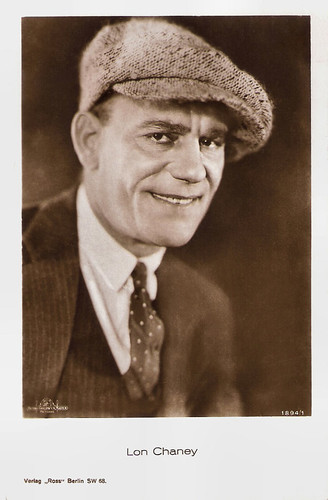
German postcard by Ross Verlag, no. 1894/1, 1927-1928. Photo: MGM / FaNuMet.

German postcard by Ross Verlag, no. 3790/1, 1928-1929. Photo: MGM. Lon Chaney in Mr. Wu (William Nigh, 1927).

German postcard by Ross Verlag, no. 4349/1, 1929-1930. Photo: MGM. Lon Chaney in The Big City (Tod Browning, 1928).

German postcard by Ross Verlag, no. 4641/1, 1929-1930. Photo: Metro-Goldwyn-Mayer. Lon Chaney in Where East Is East (Tod Browning, 1929).
Communicating through pantomime, sign language and facial expression
Leonidas Frank ‘Lon’ Chaney was born in Colorado Springs, Colorado, in 1883. He was the son of deaf-mute parents, Frank and Emma Chaney, and he learned from childhood to communicate through pantomime, sign language and facial expression. The stagestruck Chaney worked in a variety of backstage positions at the opera house in his hometown of Colorado Springs. Only 17, he was eventually allowed to appear on stage.
In 1901, he went on the road as an actor in a play that he co-wrote with his brother, The Little Tycoon. After limited success, the company was sold. He began travelling with popular Vaudeville and theatre acts. On tour in Oklahoma City, he met Francis Cleveland ‘Cleva’ Creighton, (Cleva) who was auditioning for a part in the show as a singer.
In 1905, Chaney, then 22, married 16-year-old Cleva and in 1906, their only child, a son, Creighton Tull Chaney (later known as film actor Lon Chaney, Jr.) was born. The Chaneys continued touring, settling in California in 1910. Their marriage became strained due to working conditions, money and jealousy. In 1913, Cleva went to the Majestic Theater in downtown Los Angeles, where Lon was managing the Kolb and Dill show and attempted suicide by swallowing mercuric chloride. The suicide attempt failed but it ruined her voice.
The ensuing scandal and divorce forced Chaney out of the theatre and into the booming industry of silent films. Between 1912 and 1917, Chaney worked under contract for Universal Studios doing a hundred bit or character parts. His skill with makeup gained him many parts in the highly competitive casting atmosphere. During this time, Chaney befriended the husband-wife director team of Joe De Grasse and Ida May Park, who gave him substantial roles in their pictures, and further encouraged him to play macabre characters.
Chaney married one of his former colleagues in the Kolb and Dill company tour, chorus girl Hazel Hastings. Little is known of Hazel, except that her marriage to Chaney was solid. The couple gained custody of Chaney's 10-year-old son Creighton, who had resided in various homes and boarding schools since Chaney's divorce from Cleva.
In 1917 Universal presented Chaney, Dorothy Phillips, and William Stowell as a team in the drama The Piper's Price (Joe De Grasse, 1917). In succeeding films, the men alternated playing lover, villain, or the other man to the beautiful Phillips. They would occasionally be joined by Claire Du Brey nearly making the trio a quartet of recurring actors from film to film. So successful were the films starring this group that Universal produced fourteen films from 1917 to 1919 with Chaney, Stowell, and Phillips.
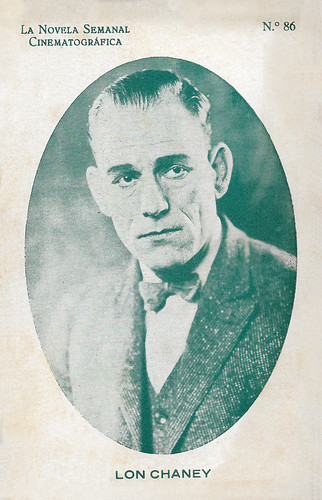
Spanish postcard by La Novela Semanal Cinematografica, no. 86.
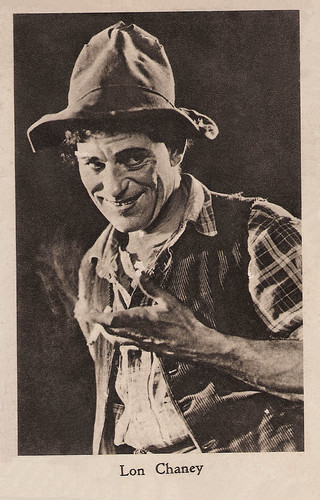
Spanish postcard in the Collectiõn de 14 postales Artistas Cinematograficasby ISMI / Huegograbado, Mumbru, Barcelona, serie A, no. 13. Photo: Universal Film. Lon Chaney in The Trap (Robert Thornby, 1922).

German postcard by Bruckmann-Verleih. Photo: Universal. Lon Chaney and Mary Philbin in The Phantom of the Opera (Rupert Julian, 1925). Caption: "Premiere at the Primus Palast 5 November 1925."

Italian programme card for Il Cinema Ritrovata 2011. Photo: Lon Chaney and Mary Philbin in Phantom of the Opera (Rupert Julian, 1925).

Italian postcard by G.B. Falci, Milano, no. 66. Photo: Metro-Goldwyn-Mayer. Lon Chaney and Renée Adorée in Mr. Wu (1927).
A con man who pretends to be a cripple and is miraculously healed
By 1917 Lon Chaney was a prominent actor of the Universal studio, but his salary did not reflect this status. When Chaney asked for a raise, studio executive William Sistrom replied, "You'll never be worth more than one hundred dollars a week." After leaving the studio, Chaney struggled for the first year as a free-lance character actor.
He got his first big break when playing a substantial role in William S. Hart's Western, Riddle Gawne (William S. Hart, Lambert Hillyer, 1918). He received high praise for his performance in the role. In 1919, Chaney had another breakthrough performance in The Miracle Man (George Loane Tucker, 1919), as The Frog, a con man who pretends to be a cripple and is miraculously healed. The film displayed not only Chaney's acting ability but also his talent as a master of makeup. Critical praise and a gross of over $2 million put Chaney on the map as America's foremost character actor.
He exhibited great adaptability with makeup in more conventional crime and adventure films, such as The Penalty (Wallace Worsley, 1920), in which he played an amputee gangster. As Quasimodo in The Hunchback of Notre Dame (Wallace Worsley, 1923) and Erik, the tortured opera ghost in The Phantom of the Opera (Rupert Julian, 1925), Chaney created two of the most grotesquely deformed characters in film history.
William K. Everson in American Silent Film: "Only 'The Phantom of the Opera,' with its classic unmasking scene, a masterpiece of manipulative editing, really succeeded (and still does!) in actually scaring the audience - and that because the revelation had to be a purely visual one. Moreover, Lon Chaney's make-up was so grotesque as to equal, if not surpass, anything that the audience might have anticipated or imagined."
Chaney also appeared in ten films directed by Tod Browning, often portraying disguised and/or mutilated characters. His portrayals sought to elicit a degree of sympathy and pathos among viewers not overwhelmingly terrified or repulsed by the monstrous disfigurements of these victims of fate.

French postcard by Cinémagazine-Édition, Paris, no. 292.
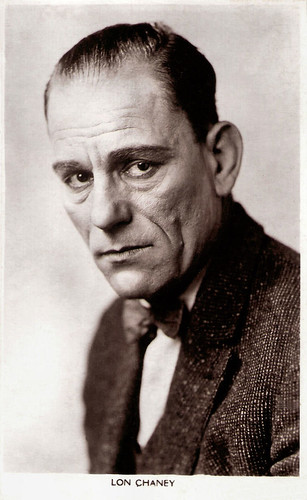
British postcard in the Picturegoer Series, London, no. 43.

British postcard in the Picturegoer Series, London, no. 43a.

German postcard by Ross Verlag, no. 1526/1, 1927-1928. Photo: Fanumet. Collection: Didier Hanson.

German postcard by Ross Verlag, no. 4349/2, 1929-1930. Image: MGM. Collection: Didier Hanson.
One of the most legendary and sought-after lost films
In 1924, Lon Chaney starred in Metro-Goldwyn’s He Who Gets Slapped, a circus melodrama voted one of the best films of the year. The success of this film led to a series of contracts with MGM Studios for the next five years. In these final five years of his film career, Chaney gave some of his most memorable performances.
His portrayal of a tough-as-nails marine drill instructor opposite William Haines in Tell It to the Marines (George W. Hill, 1926), one of his favourite films, earned him the affection of the Marine Corps, who made him their first honorary member of the motion picture industry. Memorable is also his carnival knife-thrower Alonzo the Armless in The Unknown (Tod Browning, 1927) opposite Joan Crawford.
In 1927, Chaney also co-starred with Conrad Nagel and Marceline Day in the horror film London After Midnight (Tod Browning, 1927), considered one of the most legendary and sought-after lost films. His final film role was a sound remake of his silent classic The Unholy Three (Jack Conway, 1930). He played Echo, a crook ventriloquist and used five different voices (the ventriloquist, the old woman, a parrot, the dummy and the girl) in the film, thus proving he could make the transition from silent films to the talkies. Chaney signed a sworn statement declaring that the five voices in the film were his own.
During the filming of Thunder in the winter of 1929, Chaney developed pneumonia. In late 1929 the heavy smoker was diagnosed with bronchial lung cancer. This was exacerbated when artificial snow, made out of cornflakes, lodged in his throat during filming and quickly created a serious infection. Despite aggressive treatment, his condition gradually worsened, and seven weeks after the release of the remake of The Unholy Three (1930), he died of a throat haemorrhage in Los Angeles, California.
In his last days, his illness had rendered him unable to speak, forcing him to rely on the pantomimic gestures of his youth in order to communicate with his friends and loved ones. Chaney and his second wife Hazel had led a discreet private life distant from the Hollywood social scene. Chaney did minimal promotional work for his films and for Metro-Goldwyn-Mayer, purposefully fostering a mysterious image, and he reportedly intentionally avoided the social scene in Hollywood.
At the end of the 1950s, Lon Chaney was rediscovered. He was portrayed by James Cagney in the biopic Man of a Thousand Faces (Joseph Pevney, 1957). In 1958, Chaney fan Forrest J. Ackerman started and edited the magazine Famous Monsters of Filmland, which published many photographs and articles about Chaney. Ackerman is also present in Kevin Brownlow’s documentary Lon Chaney: A Thousand Faces (2000).

British postcard, no. 142.

French postcard by A.N., Paris, no. 52. Photo: Universal Film. Lon Chaney in The Trap (Robert Thornby, 1922).
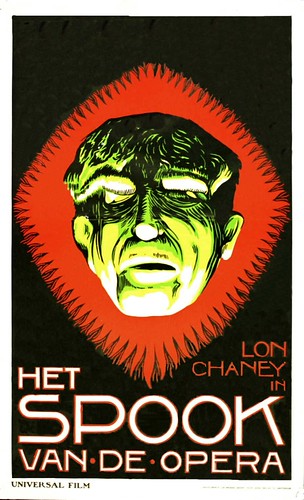
Dutch poster by Frans Bosen for The Phantom of the Opera (Rupert Julian, 1925) with Lon Chaney.

German postcard by Ross Verlag, no. 3052/1, 1928-1929. Photo: MGM / Fanumet. Publicity still for Mr. Wu (William Nigh, 1927). Collection: Didier Hanson.

A playing card with Lon Chaney as the Joker. Lon Chaney in London After Midnight (Tod Browning, 1927).
Sources: Hal Erickson (AllMovie), Lon Chaney.com, Silents are Golden, Wikipedia and IMDb.
No comments:
Post a Comment